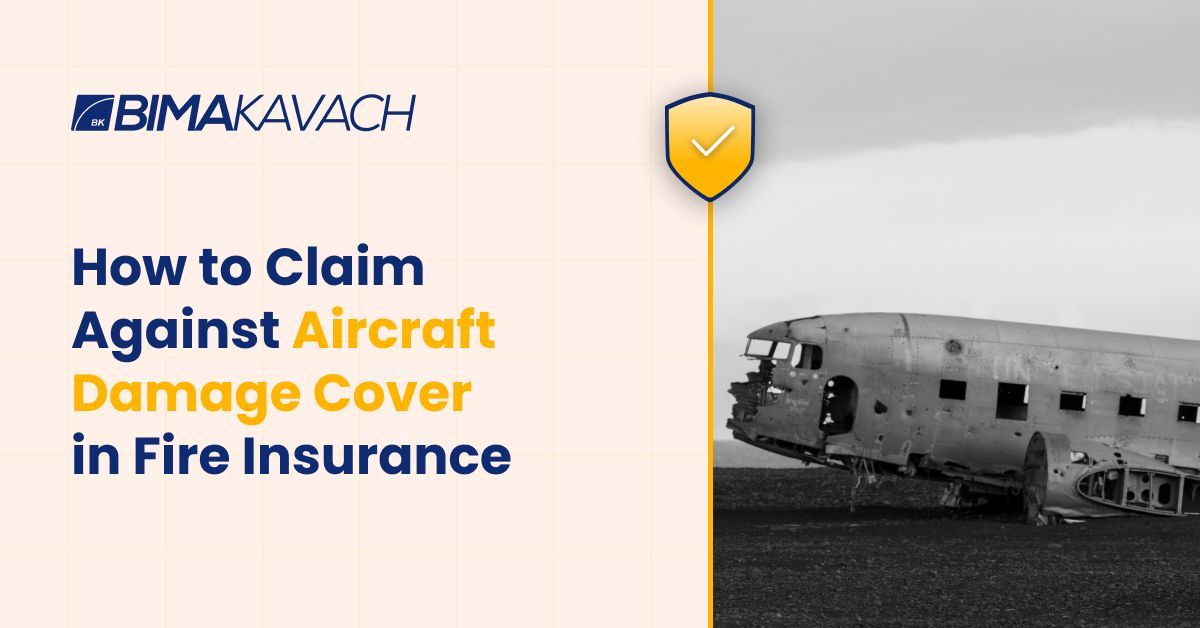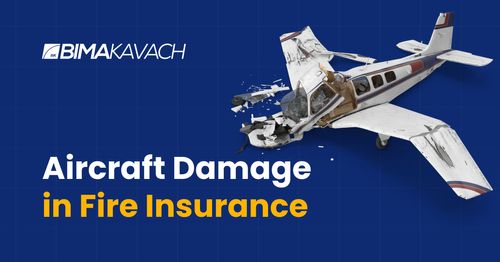Fire insurance is a crucial aspect of risk management for property owners in India, providing financial protection against various perils, including fire-related incidents. One aspect of fire insurance that is often overlooked is the coverage for damage caused by aircraft. In this article, we will investigate how fire insurance policies in India typically handle damage to property resulting from aircraft-related incidents.
What is the Aircraft Damage Coverage in Fire Insurance?
Aircraft damage coverage is a specific provision within fire insurance policies that addresses the potential risks associated with damage caused by aircraft. This coverage extends beyond traditional fire hazards and includes events such as aircraft crashes, debris fallout, or other damages resulting from aviation-related incidents. Usually, Aircraft Damage cover is an optional cover that you can purchase in addition to standard fire insurance coverage.
Key Components of Aircraft Damage Coverage
Crash Damage:
In the unfortunate event of an aircraft crash on or near the insured property, a comprehensive fire insurance policy typically covers the resulting damage. This can include structural damage to buildings, loss of personal property, and any other destruction caused by the impact.
Debris Fallout:
Sometimes, aircraft accidents may result in debris falling onto nearby properties. Fire insurance policies often include coverage for damages caused by debris fallout, encompassing both structural and content damage.
Third-Party Liability:
Fire insurance policies may also cover third-party liability arising from aircraft-related incidents. This could involve damage to neighboring properties or injuries to individuals caused by an aircraft accident on or near the insured premises.
Legal Expenses:
In the aftermath of an aircraft-related incident, legal proceedings may be initiated. Fire insurance policies may include provisions for legal expenses incurred in defending the insured against liability claims arising from the incident.
Get Free Quote in Minutes
What are excluded from Aircraft Damage Coverage in Fire Insurance?
- Loss or damage to property caused by war or allied perils
- Loss or damage to property caused by nuclear or allied perils
- Pollution or contamination of property
- Loss or damage to property caused by an earthquake, volcanic eruption, or other convulsions of nature
- Loss or damage to property caused by pressure waves from an aircraft traveling at supersonic speed
- Loss of property by theft during or after the occurrence of any insured peril
- Riot, Strike, or Malicious Damage (RSMD) losses arising from total or partial cessation of work or permanent or temporary dispossession resulting from an order of the government
- Coastal or river erosion
- Forest fire
- Loss or damage by spoilage resulting from the retardation of any process caused by the operation of any insured perils.

How to claim against Aircraft Damage cover in Fire Insurance?
Claiming against Aircraft Damage cover in a fire insurance policy typically involves a specific process. Keep in mind that insurance policies and procedures can vary, so it's important to refer to your policy documents and contact BimaKavach experts for accurate and detailed information. However, here is a general guide on how you might proceed:
· Document the Incident:
It's crucial to gather as much information as possible about the incident. Take photos or videos of the damage, and if there are any eyewitnesses, try to obtain their contact information. Make note of the date, time, and any other relevant details.
· Notify the Insurance Company:
Contact your insurance company as soon as possible to report the incident. Provide them with a detailed description of what happened, along with any supporting documentation, such as photos and videos. Be prepared to provide your policy number and any other relevant information.
· Follow the Claims Process:
Your insurance provider will guide you through the claims process. They may ask you to fill out a claims form, which typically includes details about the incident, the extent of the damage, and any other relevant information. Be thorough and honest when providing information.
· Cooperate with the Investigation:
The insurance company may conduct an investigation to assess the validity and extent of the claim. Cooperate fully with their requests for information or documentation. This may include providing additional details about the incident, allowing for inspections, or answering questions from their claim adjusters.
· Obtain Repair Estimates:
Depending on the extent of the damage, you may need to obtain repair estimates from qualified professionals. Your insurance company may have preferred providers or guidelines for obtaining repair estimates.
· Review the Settlement Offer:
If your claim is approved, the insurance company will provide a settlement offer. Review this carefully and, if necessary, discuss any concerns or negotiate with the insurance adjuster to ensure you are adequately compensated for the damages covered under your policy.
· Claim Payout:
If you accept the settlement offer, the insurance company will process the payout according to the terms of your policy.
What determines the cost of an Aircraft Damage Cover in Fire Insurance?
The cost of additional coverage against damage caused by aircraft in fire insurance, often referred to as "Aircraft Damage Cover" or "Aircraft Impact Cover," is influenced by several factors. Insurance companies assess these factors to determine the level of risk associated with providing coverage for damage caused by aircraft. Here are some key considerations that can impact the cost of this specific coverage:
1.Location of the Property: The geographic location of the insured property can affect the cost of coverage. Properties located near airports or in the vicinity of flight paths may face a higher risk of aircraft-related incidents, impacting the premium.
2. Property Type and Use: The type of property being insured and its use can impact the cost of coverage. For example, commercial properties or critical infrastructure near airports may have higher premiums compared to residential properties.
3. Property Value: The value of the insured property is a significant factor. Higher-value properties typically command higher premiums for additional coverage.
4. Risk Mitigation Measures: The presence of risk mitigation measures, such as safety barriers, security protocols, or other protective measures, can influence the premium. Implementing measures that reduce the risk of aircraft-related damage may result in lower premiums.
5. Claims History: The claims history of the insured property or its vicinity can affect the cost of coverage. A history of previous aircraft-related incidents may lead to higher premiums.
6. Construction and Building Materials: The construction and building materials of the property can impact the cost of coverage. Fire-resistant materials or structures may result in lower premiums.
7. Insurance Limits and Deductibles: The coverage limits and deductibles chosen by the policyholder can affect the premium. Higher coverage limits or lower deductibles may result in higher premiums.
Conclusion:
Aircraft damage coverage in fire insurance policies is a valuable safeguard for property owners in India. As aviation continues to play a significant role in modern society, the potential for aircraft-related incidents impacting properties remains a relevant concern. Property owners are encouraged to thoroughly understand the terms of their fire insurance policies, ensuring they have adequate coverage for potential damages caused by aircraft.
In this context, consulting with insurance professionals and staying informed about policy updates is crucial for property owners seeking comprehensive protection against aircraft-related incidents. With the right coverage in place, property owners can have peace of mind, knowing that their investments are safeguarded in the event of an unexpected aircraft-related event.
Frequently Asked Questions
1. What losses are typically covered by a fire insurance policy?
Fire insurance policies usually cover losses caused by fire, lightning, explosion, and other related perils. The policy may also cover damage caused by smoke, water, and debris removal. However, it is important to read the policy document carefully to understand the specific terms and conditions of coverage.
2. What is the impact damage in a fire policy?
Impact damage refers to damage caused by objects falling on the insured property, such as trees, aircraft, or vehicles. In a fire insurance policy, impact damage is usually covered as one of the perils.
3. How can I make an insurance claim for fire damage?
To make an insurance claim for fire damage, the insured should notify the insurance company as soon as possible and provide all the necessary information and documentation, such as the policy number, date of loss, and proof of ownership. The insurance company will then investigate the claim and determine the amount of compensation.
4. What are the 12 perils covered under fire insurance?
The 12 perils covered under fire insurance are fire, lightning, explosion, aircraft impact, riot, strike, malicious damage, storm, tempest, flood, bursting or overflowing of water tanks, pipes, and apparatus, and earthquake.

